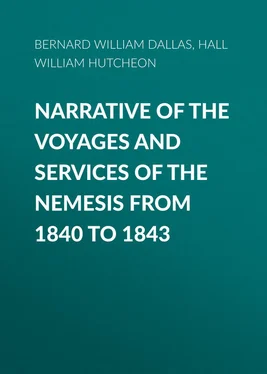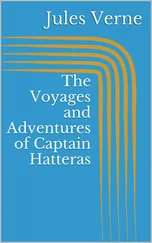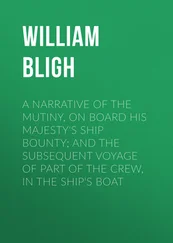William Hall - Narrative of the Voyages and Services of the Nemesis from 1840 to 1843
Здесь есть возможность читать онлайн «William Hall - Narrative of the Voyages and Services of the Nemesis from 1840 to 1843» — ознакомительный отрывок электронной книги совершенно бесплатно, а после прочтения отрывка купить полную версию. В некоторых случаях можно слушать аудио, скачать через торрент в формате fb2 и присутствует краткое содержание. Жанр: foreign_antique, foreign_prose, на английском языке. Описание произведения, (предисловие) а так же отзывы посетителей доступны на портале библиотеки ЛибКат.
- Название:Narrative of the Voyages and Services of the Nemesis from 1840 to 1843
- Автор:
- Жанр:
- Год:неизвестен
- ISBN:нет данных
- Рейтинг книги:5 / 5. Голосов: 1
-
Избранное:Добавить в избранное
- Отзывы:
-
Ваша оценка:
- 100
- 1
- 2
- 3
- 4
- 5
Narrative of the Voyages and Services of the Nemesis from 1840 to 1843: краткое содержание, описание и аннотация
Предлагаем к чтению аннотацию, описание, краткое содержание или предисловие (зависит от того, что написал сам автор книги «Narrative of the Voyages and Services of the Nemesis from 1840 to 1843»). Если вы не нашли необходимую информацию о книге — напишите в комментариях, мы постараемся отыскать её.
Narrative of the Voyages and Services of the Nemesis from 1840 to 1843 — читать онлайн ознакомительный отрывок
Ниже представлен текст книги, разбитый по страницам. Система сохранения места последней прочитанной страницы, позволяет с удобством читать онлайн бесплатно книгу «Narrative of the Voyages and Services of the Nemesis from 1840 to 1843», без необходимости каждый раз заново искать на чём Вы остановились. Поставьте закладку, и сможете в любой момент перейти на страницу, на которой закончили чтение.
Интервал:
Закладка:
Безопасно оплатить книгу можно банковской картой Visa, MasterCard, Maestro, со счета мобильного телефона, с платежного терминала, в салоне МТС или Связной, через PayPal, WebMoney, Яндекс.Деньги, QIWI Кошелек, бонусными картами или другим удобным Вам способом.
1
She subsequently, also, carried five long brass 6-pounders, two on each side, and one upon the bridge; and had also ten small iron swivels along the top of her bulwarks, besides boat guns and small arms.
2
Nominal list of Officers who served on board the Nemesis during the period referred to in this work: —
William H. Hall, R.N., Commander – Promoted to Commander, 10th June, 1843;
Lieutenant William Pedder, R.N., First Officer – Made Harbour Master and Marine-magistrate at Hong-Kong, July, 1841;
Mr. Ed. L. Strangways, Mate, R.N., Second Officer – Left sick, 29th March, 1841; Lieutenant, 23rd Dec. 1842;
Mr. John Laird Galbraith, Third Officer – Made Second Officer, 29th March, 1841; and First Officer, 1st July, 1842; and paid off at Calcutta, March, 1843;
Mr. F. W. Whitehurst, Fourth Officer – Made Third Officer, 29th March, 1841; and Second Officer, 1st July, 1842; and paid off at Calcutta, March, 1843;
Mr. Peter Young, M.R.C.S., Surgeon – Left the vessel, 15th January, 1841, at Macao;
Mr. John Gaunt, Purser – Served during the whole period. N.B. – The above joined the Nemesis in England.
The following officers joined the Nemesis at different periods in China: —
Mr. John Turner, Surgeon – Joined 15th Jan. 1841, at Macao; made Assistant-Surgeon, Bombay Establishment, Oct. 1843;
Mr. A. T. Freese, Mate, R.N., First Officer – Joined 1st August, 1841, at Hong-Kong; left the vessel 30th June, 1842; Lieutenant, 23rd Dec. 1842;
Mr. Alfred Fryer, Fourth Officer – Joined 1st February, 1842, at Chusan; paid off and rejoined at Calcutta, 1843;
Mr. B. G. Dryden, Second Officer – Joined 1st July, 1842, at Woosung; ditto
Mr. Arthur Baker, Volunteer – Joined 24th August, 1842; Yangtze river; ditto
Engineers – Mr. Colin M'Lougal (killed), Mr. John Kinross, Mr. Henry L. Harley, Mr. William Lang, Mr. David Wilson, Robert Kelly.
N.B. – Mr. Crouch, Mate, R.N., served on board as gunnery-mate, from the Wellesley, by permission of Commodore Sir Gordon Bremer, at Chuenpee, at First Bar Action, and Inner Passage, &c. Promoted Lieutenant, 8th June, 1841; Commander, 25th October, 1843. Wounded at Chin-keang-foo.
3
A native African from the so-called Kroo country.
4
About one thousand logs make up twenty-two tons and a half of fire-wood.
5
Another remark, perhaps worthy of being attended to, suggested itself on this occasion, and it has been frequently confirmed since – namely, that no steamer constructed according to the model of the Nemesis should be sent to sea upon a long and uncertain voyage, without having a fixed keel running the whole way fore and aft, and bolted strongly through her bottom. This would be found of the greatest possible utility at sea, and it could easily be taken off, and the moveable keels put on, whenever the vessel were employed on a coast, or in river navigation.
It may further be questionable, in the event of a smaller steamer being intended to be sent out, whether it would not be both safer and less expensive to send it in pieces , and have it put together, by the mechanics and engineers belonging to it, at the place where it might be destined for use, than to send it ready equipped, to make its own way to its destination by steam and canvas, with all the necessary risk.
6
The mode in which the permanent repairs were afterwards effected will be explained in the fifth chapter, together with the method by which the recurrence of a similar accident has been provided against in vessels more recently constructed.
7
It will be remembered that the plagues were frogs; dust turned to lice; swarms of flies; the murrain of beasts; the plague of boils and blanes; the plague of hail, of locusts, and of darkness.
8
In the account given of the Egyptian plague, it is stated "that the locusts were brought by an east wind," and were carried away "by a mighty strong west wind." I was curious to ascertain whether there was anything worth noting in relation to the state of the wind at Delagoa Bay when the locusts appeared, and when they were carried away again. On referring to the ship's log, I find that the day preceding the appearance of the locusts was one of perfect calm; but the morning of the day on which they came was ushered in by a north-east wind, which lasted until the evening, when it changed round to precisely the opposite quarter – namely, to the south-west, and increased on the following day to a strong gale from the same quarter, which carried away all the locusts. Subsequently, it again veered round to the north-east, and continued so for several days, but brought no more locusts.
9
With respect to the effects of lightning upon an iron ship, and the danger which was to be apprehended from the attraction, both of the vessel as a body, and of its particular parts as points for the electrical fluid to touch upon in its passage between the clouds and the earth, no inconvenience whatever seems to have been felt. Much had been said about it in England before her departure for a tropical region. The timid, and those less acquainted with the subject, openly expressed their apprehensions; the learned smiled with more of curiosity than fear; but the officers of the vessel itself were too busy about other matters to give themselves time to think much about the question. During their voyage to the southward, when many dangers were encountered, certainly that from lightning was amongst the least thought of; and now, as they were passing through the Mozambique Channel, a part of the world particularly famous for its heavy storms of thunder and lightning, not the slightest effect from it was observed upon the iron vessel. The funnel has a perfectly smooth top, without any ornamental points, such as are sometimes seen; and the main rigging and funnel stays were made of chain at the top, and rope throughout the rest.
10
The sultan very recently went up to Calcutta, to apply to the Governor-general, in the hope that the Company might be induced to take possession of the islands, which he felt he could no longer hold without assistance. He merely asked for himself a small annual stipend out of the revenues. What answer he may have received is not known; but probably his application was rejected, upon the ground of our territory in the East being already quite large enough. But, in reality, the Comoro Islands, or at least a part of them, must be viewed in a political light, as they may be said to command the navigation of the straits, and are generally thought to be an object aimed at by the French.
11
The following letter concerning the fate of the Comoro Islands, and the violent proceedings of the French in that quarter, appeared in The Times of January 30th, 1844. The facts stated in it have every appearance of exaggeration, but the interference of the British government would seem to be called for.
"The French have, within the last month, obtained, by fraud, possession of the islands of Johanna, Mohilla, and Peonaro; they had already, by the same means, obtained the islands of Mayotte and Nos Beh. There are at present out here eleven ships of war – the largest a 60-gun frigate; more are expected out, in preparation for the conquest of all Madagascar; and also, it is said, of the coast of Africa, from latitude 10 S. to 2 S.; this portion includes the dominions of the Imaum of Muscat. At this place (Nos Beh) a system of slavery is carried on that you are not aware of. Persons residing here, send over to places on the mainland of Africa, as Mozambique, Angoza, &c., money for the purchase of the slaves; they are bought there for about ten dollars each, and are sold here again for fifteen dollars; here again they are resold to French merchant vessels from Bourbon and St. Mary's for about twenty-five to thirty dollars each. Captains of vessels purchasing these use the precaution of making two or three of the youngest free, and then have them apprenticed to them for a certain term of years, (those on shore,) fourteen and twenty one years. These papers of freedom will answer for many. It is a known fact, that numbers have been taken to Bourbon, and sold for two hundred and three hundred dollars each. Those who have had their freedom granted at this place, (Nos Beh,) as well as others, are chiefly of the Macaw tribe. The Indian, of Havre, a French bark, took several from this place on the 20th of September last; she was bound for the west coast of Madagascar, St. Mary's, and Bourbon. L'Hesione, a 32-gun frigate, has just arrived from Johanna, having compelled one of the chiefs to sign a paper, giving the island up to the French. On their first application, the king and chiefs of Johanna said, that the island belonged to the English. The French then said, that if it was not given up, they would destroy the place; they, after this, obtained the signature of one of the chiefs to a paper giving up the island to the French.
Читать дальшеИнтервал:
Закладка:
Похожие книги на «Narrative of the Voyages and Services of the Nemesis from 1840 to 1843»
Представляем Вашему вниманию похожие книги на «Narrative of the Voyages and Services of the Nemesis from 1840 to 1843» списком для выбора. Мы отобрали схожую по названию и смыслу литературу в надежде предоставить читателям больше вариантов отыскать новые, интересные, ещё непрочитанные произведения.
Обсуждение, отзывы о книге «Narrative of the Voyages and Services of the Nemesis from 1840 to 1843» и просто собственные мнения читателей. Оставьте ваши комментарии, напишите, что Вы думаете о произведении, его смысле или главных героях. Укажите что конкретно понравилось, а что нет, и почему Вы так считаете.












